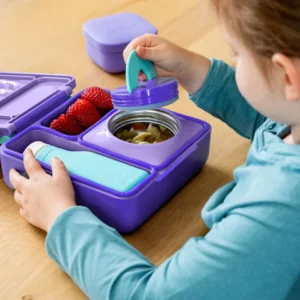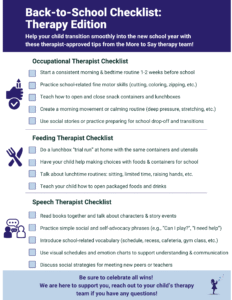As summer winds down, many families start preparing for the back-to-school season. Back-to-school is a time full of excitement, change, and often a few nerves (for both kids and parents!). Whether your child is starting preschool or kindergarten, heading into a new grade, or transitioning to a different school setting, this can be a big adjustment.
At More to Say, our team of pediatric occupational therapists, speech-language pathologists, and feeding therapists work closely with families to help children feel confident and ready for the school year ahead. Here are some expert tips from each of our disciplines to help your child return to school feeling calm, prepared, and supported.
_____
Occupational Therapist Tips
1. Start a Consistent Routine Early
Children thrive on predictability. Begin waking up, eating, and going to bed at school-time hours at least 1-2 weeks before school starts. Routines ease transitions and reduce stress.
2. Build Fine Motor Readiness
Encourage play that promotes hand strength and coordination such as cutting with scissors, coloring, opening containers, or building with small blocks. These skills are key for classroom tasks.
3. Encourage Independence with Daily Tasks
Practice putting on backpacks, managing zippers and buttons, and opening lunch containers. These life skills build confidence and reduce frustration during the school day.
4. Support Sensory Regulation
Each child processes sensory input differently. Some may need movement breaks in the morning (jumping, stretching, animal walks, etc.) or calming routines (deep pressure, yoga) to feel regulated. If you feel that your child needs more individualized sensory inputs for regulation, you can reach out to us to schedule an occupational therapy evaluation.
5. Prepare for Transitions
If transitions are tough for your child, try practicing school scenarios or using social stories to make new routines feel more predictable.

_____
Speech-Language Pathologist Tips
1. Strengthen Language and Literacy Skills
Read books aloud and talk about the story:
- Who are the characters?
- What’s the problem?
- How did they solve it?
This helps boost reading comprehension and expressive language.
2. Practice Social Communication
Practice situations like asking for help, taking turns, or joining a group at recess. If your child is shy or has difficulties navigating social scenarios, even simple scripts like “Can I play?” can go a long way in building confidence in your child when meeting new friends.
3. Expand School-Related Vocabulary
Introduce words they might hear at school such as, “schedule”, “assembly”, “cafeteria”, “recess” and model how to use them in real-life context.
4. Use Visual Supports
Picture schedules and emotion charts can help children understand expectations and express themselves with less frustration.
5. Model Self-Advocacy Phrases
Modeling language like, “I need help”, “Where do I go?”, or “I feel upset” can help your child feel more confident advocating for themselves at school.

_____
Feeding Therapist Tips
1. Practice “Lunchbox Dress Rehearsals”
Let your child practice eating from their actual lunchbox at home. This includes using the same containers, utensils, and even napkins they’ll use at school. This also gives you the opportunity to see which containers, if any, are difficult for your child to open/close, giving you time to practice before school officially starts!
2. Stick to Familiar Foods
Avoid experimenting with new foods in the first few weeks. Pack safe, preferred foods your child is most likely to eat in a busy, sometimes overstimulating lunchroom environment.
3. Support Mealtime Independence
Make sure your child can open packages, peel fruit, and manage any thermos or container you plan to send. These little skills matter a lot in the lunchroom!
4. Talk about Lunchtime Expectations
Explain school mealtime rules: sitting in one spot, limited time to eat, and not always having an adult to help immediately. Practicing these ideas ahead of time can reduce nerves and give you the opportunity to teach your child how to advocate for themselves if they do need help in the lunchroom.
5. Involve Your Child in Meal Prep
Letting your child help pack their lunch and choose containers can give them a sense of ownership, and even increase the chance they’ll eat what’s inside!

_____
Bonus Tips from Our Whole Therapy Team
1. Communicate with Your Child’s Teachers
Share important info like sensory needs, feeding preferences, or communication strategies early in the year. Collaboration goes a long way!
2. Watch for Signs of Overwhelm
It’s normal for children to be tired or emotional during the first few weeks. If you notice persistent difficulty with transitions, regulation, academic performance, or feeding, we’re here to help.
3. Celebrate Progress
Whether your child opens their lunch independently, asks for help, or gets dressed without reminders, acknowledge their success! Positive reinforcement builds self-esteem.

_____
We’re Here for You This School Year!
At More to Say, we’re more than just therapists, we’re your partners in helping your child thrive. If you have any concerns about your child’s development, behavior, communication, or school readiness, don’t hesitate to reach out. Together, we can make this a great school year for your child.
Want to check in before school starts? Contact us to schedule an OT, speech, or feeding therapy evaluation today. We also offer free phone screenings to determine if your child could benefit from a full evaluation.
Phone: (203)828-6790
Email: info@moretosayct.com


